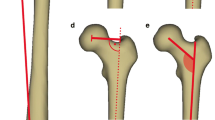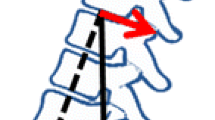Abstract
Purpose
Human fully upright ambulation, with fully extended hips and knees, and the body’s center of gravity directly above the hips, is unique in nature, and distinguishes humans from all other mammalians. This bipedalism is made possible by the development of a lordosis between the ischium and ilium; it allows to ambulate in this unique bipedal manner, without sacrificing forceful extension of the legs. This configuration in space introduces unique biomechanical forces with relevance for a number of spinal conditions. The aim of this study was to quantify the development of this lordosis between ischium and ilium in the normal growing and adult spine and to evaluate its correlation with the well-known clinical parameter, pelvic incidence.
Methods
Consecutive series of three-dimensional computed tomography scans of the abdomen of 189 children and 310 adults without spino-pelvic pathologies were used. Scan indications were trauma screening or acute abdominal pathology. Using previously validated image processing techniques, femoral heads, center of the sacral endplate and the axes of the ischial bones were semi-automatically identified. A true sagittal view of the pelvis was automatically reconstructed, on which ischio-iliac angulation and pelvic incidence were calculated. The ischio-iliac angle was defined as the angle between the axes of the ischial bones and the line from the midpoint of the sacral endplate to the center of the femoral heads.
Results
A wide natural variation of the ischio-iliac angle (3°–46°) and pelvic incidence (14°–77°) was observed. Pearson’s analysis demonstrated a significant correlation between the ischio-iliac angle and pelvic incidence (r = 0.558, P < 0.001). Linear regression analysis revealed that ischio-iliac angle, as well as pelvic incidence, increases during childhood (+7° and +10°, respectively) and becomes constant after adolescence.
Conclusions
The development of the ischio-iliac lordosis is unique in nature, is in harmonious continuity with the highly individual lumbar lordosis and defines the way the human spine is biomechanically loaded. The practical parameter that reflects this is the pelvic incidence; both values increase during growth and remain stable in adulthood.





Similar content being viewed by others
References
Abitbol MM (1988) Evolution of the ischial spine and of the pelvic floor in the Hominoidea. Am J Phys Anthropol. doi:10.1002/ajpa.1330750107
Alexander RM (2004) Bipedal animals, and their differences from humans. J Anat. doi:10.1111/j.0021-8782.2004.00289.x
Been E, Gomez-Olivencia A, Kramer PA (2014) Lumbar lordosis in extinct hominins: Implications of the pelvic incidence. Am J Phys Anthropol. doi:10.1002/ajpa.22507
Berge C (1998) Heterochronic processes in human evolution: an ontogenetic analysis of the hominid pelvis. Am J Phys Anthropol 105:441–459
Boulay C, Tardieu C, Hecquet J, Benaim C, Mouilleseaux B, Marty C, Prat-Pradal D, Legaye J, Duval-Beaupère G, Pélissier J (2006) Sagittal alignment of spine and pelvis regulated by pelvic incidence: standard values and prediction of lordosis. Eur Spine J 15:415–422
Castelein RM, van Dieën JH, Smit TH (2005) The role of dorsal shear forces in the pathogenesis of adolescent idiopathic scoliosis—a hypothesis. Med Hypothesis 65:501–508
Cil A, Yazici M, Uzumcugil A, Kandemir U, Alanay A, Alanay Y, Acaroglu RE, Surat A (2005) The evolution of sagittal segmental alignment of the spine during childhood. Spine (Phila Pa 1976) 30:93–100
D’Août K, Vereecke E, Schoonaert K, De Clercq D, Van Elsacker L, Aerts P (2004) Locomotion in bonobos (Pan paniscus): differences and similarities between bipedal and quadrupedal terrestrial walking, and a comparison with other locomotor modes. J Anat 204:353–361
Dickson RA (1988) The aetiology of spinal deformities. Lancet 1:1151–1155
Greiner TM (2002) The morphology of the gluteus maximus during human evolution: Prerequisite or consequence of the upright bipedal posture? Hum Evol. doi:10.1007/BF02436430
Hanson DS, Bridwell KH, Rhee JM, Lenke LG (2002) Correlation of pelvic incidence with low- and high-grade isthmic spondylolisthesis. Spine (Phila Pa 1976) 27:2026–2029
Hresko MT, Labelle H, Roussouly P, Berthonnaud E (2007) Classification of high-grade spondylolistheses based on pelvic version and spine balance: possible rationale for reduction. Spine (Phila Pa 1976) 32:2208–2213
Kibii JM, Churchill SE, Schmid P, Carlson KJ, Reed ND, de Ruiter DJ, Berger LR (2011) A partial pelvis of Australopithecus sediba. Science. doi:10.1126/science.1202521
Kummer B (1992) Biomechanical problems of upright posture. Ann Anat 174:33–39
Labelle H, Roussouly P, Berthonnaud E, Dimnet J, O’Brien M (2005) The importance of spino-pelvic balance in L5-s1 developmental spondylolisthesis: a review of pertinent radiologic measurements. Spine (Phila Pa 1976) 30:S27–S34
Lafage V, Schwab F, Skalli W, Hawkinson N, Gagey PM, Ondra S, Farcy JP (2008) Standing balance and sagittal plane spinal deformity: analysis of spinopelvic and gravity line parameters. Spine (Phila Pa 1976) 33:1572–1578
Legaye J, Duval-Beaupere G, Hecquet J, Marty C (1998) Pelvic incidence: a fundamental pelvic parameter for three-dimensional regulation of spinal sagittal curves. Eur Spine J 7:99–103
Lorentz A (1886) Pathologie und Therapie der seitlichen Rückgrat-verkrümmungen (Scoliosis). Alfred Hölder, Vienna
Lovejoy CO (2005) The natural history of human gait and posture. Part 1. Spine and pelvis. Gait Posture. doi:10.1016/j.gaitpost.2004.01.001
Mac-Thiong JM, Labelle H, Charlebois M, Huot MP, de Guise JA (2003) Sagittal plane analysis of the spine and pelvis in adolescent idiopathic scoliosis according to the coronal curve type. Spine (Phila Pa 1976) 28:1404–1409
Mac-Thiong JM, Berthonnaud E, Dimar JR, Betz RR, Labelle H (2004) Sagittal alignment of the spine and pelvis during growth. Spine (Phila Pa 1976) 29:1642–1647
Mac-Thiong JM, Labelle H, Berthonnaud E, Betz RR, Roussouly P (2007) Sagittal spinopelvic balance in normal children and adolescents. Eur Spine J 16:227–234
Mac-Thiong JM, Wang Z, de Guise JA, Labelle H (2008) Postural model of sagittal spino-pelvic alignment and its relevance for lumbosacral developmental spondylolisthesis. Spine (Phila Pa 1976) 33:2316–2325
Mangione P, Gomez D, Sénégas J (1997) Study of the course of the incidence angle during growth. Eur Spine J 6:163–167
Nicoladoni C (1904) Anatomie und Mechanismus der Skoliose. Urban and Schwarzenberg, München Berlin Wien
Payne RC, Crompton RH, Isler K, Savage R, Vereecke EE, Gunther MM, Thorpe SK, D’Août K (2006) Morphological analysis of the hindlimb in apes and humans. II. Moment arms. J Anat 208:725–742
Pontzer H, Raichlen DA, Sockol MD (2009) The metabolic cost of walking in humans, chimpanzees, and early hominins. J Hum Evol. doi:10.1016/j.jhevol.2008.09.001
Poussa MS, Heliövaara MM, Seitsamo JT, Könönen MH, Hurmerinta KA, Nissinen MJ (2005) Development of spinal posture in a cohort of children from the age of 11–22 years. Eur Spine J 14:738–742
Rak Y (1991) Lucy’s pelvic anatomy: its role in bipedal gait. J Hum Evol 20:283–290
Robinson JT, Freedman L, Sigmon BA (1972) Some aspects of pongid and hominid bipedality. J Hum Evol 1:361–369
Roussouly P, Gollogly S, Berthonnaud E, Dimnet J (2005) Classification of the normal variation in the sagittal alignment of the human lumbar spine and pelvis in the standing position. Spine (Phila Pa 1976) 30:346–353
Tardieu C, Bonneau N, Hecquet J, Boulay C, Marty C, Legaye J, Duval-Beaupere G (2013) How is sagittal balance acquired during bipedal gait acquisition? Comparison of neonatal and adult pelves in three dimensions. Evolutionary implications. J Hum Evol. doi:10.1016/j.jhevol.2013.06.002
Vaz G, Roussouly P, Berthonnaud E, Dimnet J (2002) Sagittal morphology and equilibrium of pelvis and spine. Eur Spine J 11:80–87
Vialle R, Levassor N, Rillardon L, Templier A, Skalli W, Guigui P (2005) Radiographic analysis of the sagittal alignment and balance of the spine in asymptomatic subjects. J Bone Joint Surg Am 87:260–267
Voutsinas SA, MacEwen GD (1986) Sagittal profiles of the spine. Clin Orthop Relat Res 210:235–242
Vrtovec T, Janssen MM, Likar B, Castelein RM, Viergever MA, Pernus F (2012) A review of methods for evaluating the quantitative parameters of sagittal pelvic alignment. Spine J. doi:10.1016/j.spinee.2012.02.013
Vrtovec T, Janssen MM, Pernus F, Castelein RM, Viergever MA (2012) Analysis of pelvic incidence from three-dimensional images of a normal population. Spine (Phila Pa 1976). doi:10.1097/BRS.0b013e31823770af
Wang WJ, Crompton RH, Li Y, Gunther MM (2003) Energy transformation during erect and ‘bent-hip, bent-knee’ walking by humans with implications for the evolution of bipedalism. J Hum Evol 44:563–579
Washburn SL (1950) The analysis of primate evolution with particular reference to the origin of man. Cold Spring Harb Symp Quant Biol 15:67–78
Yoshimoto H, Sato S, Masuda T, Kanno T, Shundo M, Hyakumachi T, Yanagibashi Y (2005) Spinopelvic alignment in patients with osteoarthrosis of the hip: a radiographic comparison to patients with low back pain. Spine (Phila Pa 1976) 30:1650–1657
Conflict of interest
This authors of this study were supported by the Alexandre Suerman MD/PhD program, an unrestricted Medtronic research grant and by AOSpine, DePuy Synthes Spine and Johnson & Johnson.
Author information
Authors and Affiliations
Corresponding author
Electronic supplementary material
Below is the link to the electronic supplementary material.
Rights and permissions
About this article
Cite this article
Schlösser, T.P.C., Janssen, M.M.A., Vrtovec, T. et al. Evolution of the ischio-iliac lordosis during natural growth and its relation with the pelvic incidence. Eur Spine J 23, 1433–1441 (2014). https://doi.org/10.1007/s00586-014-3358-z
Received:
Revised:
Accepted:
Published:
Issue Date:
DOI: https://doi.org/10.1007/s00586-014-3358-z




